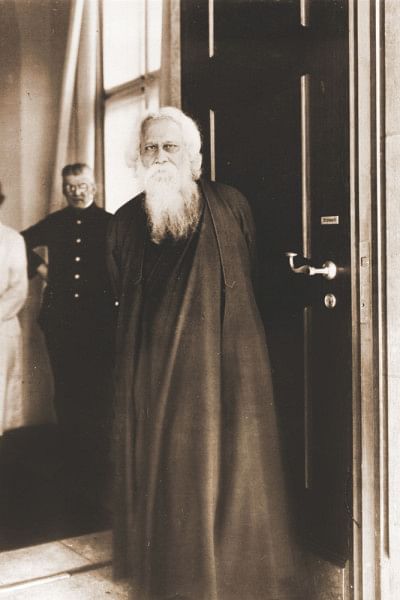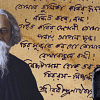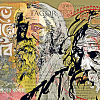A sparkle that never fades

“Rabindranath was one among the nearly seven hundred occupants at the Jorashanko Thakur Bari, and grew up with thirteen siblings: it was not that easy to be the shining star in an environment such as that,” says Tagore enthusiast and educationist Dr. A.B.M Nurul Anwar.
It also didn't help that his immediate family was littered with a group of brilliant minds. His grandfather Dwarkanath Tagore was a merchant and a well-known humanitarian. Rabi's father Maharshi Debendranath founded the Brahmo religion. The eldest brother, Dwijendranath was a philosopher. Satyendranath, another brother, was the first member of the Indian Civil Service, while Jyotirindranath was blossoming into a musician and playwright. Not to be outdone by the men of the family, Rabi's sister, Swarnakumari was a novelist and his sister-in-law an editor of a magazine. Next to this array of stars, Rabi paled in comparison, appearing shy, withdrawn and spending his days writing simple verses.
So what sparked his meteoric rise to prominence, a dominant force in the re-awakening and nurturing of Bengali culture? Dr. Anwar stresses, that Rabi's music prowess as well as his overall creative genius grew in stages, moving from strength to strength.
“Tagore was hardly 10, when his musical skills started to develop under the tutelage of illustrious artistes such as Srijon Bai, Gauharjan and Kali Mirza who frequented the Thakur Bari and performed regularly. Being a centre of the cultural scene, other noted artistes also frequented Rabi's house very regularly. Artistes such as Jodu Bhattacharji (aka Jodu Bhotto) were employed by the Tagore estate while noted musician Bishnu Chakrabarti was the family's 'house musician'. No wonder Tagore's musical construction was Dhrupad and bhanga gaan (songs recreated from Indian classical compositions) based,” he adds.
In those days, Bengali songs like Kirtan, Shyama Sangeet, Baul songs had become comatose. Except a few religious compositions, there was hardly any other variety of Bengali songs appreciated by the elites and the middle class.
“Trained in classical musical forms, whenever Rabi came across Kheyal, Baul, Kirtan and regional tunes or western forms, he tried to develop a consistent musical system that was to later take Indian music to a whole new dimension and create its own identity. Some remarkable examples of western tunes that Tagore adapted into his songs are Katobar Bhebe Chhinu, Purano Shei Din-er Katha and so on.
Rabindranath started to develop into a purist, thoroughly opposed to unnecessary ornamentation in musical notes. His music thus started to take on new forms, free of complication, which in time came to be recognised as the finest forms in music.
To express the enormity of the musical universe he composed Akash Bhora Shurjo Tara and more, with four stanzaic patterns the asthayi, ontora, shanchari and abhog following the Dhrupad form. In raga Bhairavi alone, Tagore created 25 different forms or compositions.
According to sources, several songs were inspired by regional tunes and blended easily with his compositions, for instance Baro Asha Kore (Kannada), Aaji Shubho Din-e (Kannada), Eki Labonye Purna Pran (Mysore) and Anandaloke Mangalaloke (Mysore). Kirtan, Baul and folk music too had profound impact on Rabindra Sangeet. It was during this stage that some of his outstanding work emerged such as Bhalobeshe Shokhi, Amra Milechhi Aaj Mayer Dakey, Hridayer Ekul Okul, Oke Bolo Shokhi Bolo.
His prolific style was matched by his innovative and open-minded approach -- it is said that Tagore composed Nilanjono Chhaya almost instantly after listening to a Telegu song by noted singer Sabitri Govinda.
In the phase that followed, Rabindranath's prolific nature seemed tempered by a more mature approach. He started to take an interest in folk songs, which were more soothing to the ear and more simplified than the typical raga-based songs.
Gradually, Rabindranath broke free of the conventional norms of classical music and from those 'ruins' emerged a brilliant mix of originality. During this phase, Tagore was an ardent admirer of Bishnupur Gharana of music and it showed in his work.
In the final phase, he seemed to be at his creative best, his work sparkling with ingenuity. During this phase, Tagore hardly adapted from any other songs or music of any gharana. A salient feature of his music was a unique amalgamation of classical and folk music.
In all phases through which Rabindranath's work seems to have evolved, he showed remarkable adaptability and creativity. Far from being overshadowed by the brilliance all around him in his formative years, he outshone all. During his lifetime and since, his work remains a collection of gems that sparkle and ironically, seem to grow brighter with age.

 For all latest news, follow The Daily Star's Google News channel.
For all latest news, follow The Daily Star's Google News channel. 








Comments